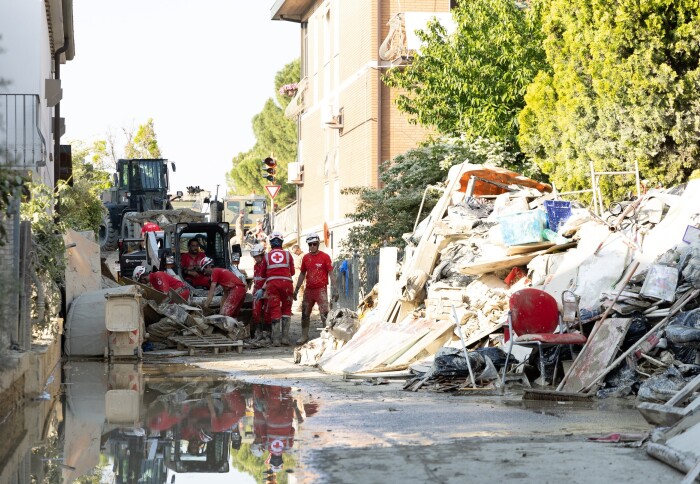Italy’s deadly floods can’t be blamed on climate change, finds study

Red Cross workers clear flood debris from an Italian street. Photo by Red Cross Italy.
Climate change is not to blame for the recent flooding in northern Italy, according to a new study by World Weather Attribution.
In May, three separate rainfall events brought a prodigious amount of rainfall to the northern Italian region of Emilia-Romagna.
Hundreds of landslides and widespread flooding devastated homes, infrastructure, and farmland, with damages totalling more than €300m.
At least 17 people died, and thousands of people were displaced from their homes.
The severity of the damages led many to link the flooding to climate change.
However, after analysing rainfall records dating back to 1960, World Weather Attribution researchers led by Dr Friederike Otto, Senior Lecturer at the Grantham Institute – Climate Change and the Environment at Imperial College London, found that spring rainfall is neither increasing nor decreasing in Emilia-Romagna.
On publishing their study, the scientists say the flooding was caused by highly unique and unusual weather conditions when three huge rainfall episodes descended on northern Italy in a short period of time.
The study found the 21-day period of rainfall was a one in a 200-year event, meaning it has very small, but not impossible - about 0.5% - chance of happening each year. Crucially, this is the same with or without human-caused climate change.
Davide Faranda, an Italian researcher at the Institut Pierre-Simon Laplace and an author of the study, says the event is the most extreme spring rainfall event on record in Emilia-Romagna.
“Our statistical findings acknowledge the uniqueness of such an event which was driven by an unprecedented sequence of three low-pressure systems in the central Mediterranean.”

Chaos and complexity
Heavy rainfall is becoming more intense and frequent due to human-caused global warming.
A warmer atmosphere can hold more moisture, so in many parts of the world, extreme rain and flooding is increasing.
However, in Emilia-Romagna, the study found that spring rainfall is neither becoming more nor less intense with climate change.

Pointing to other scientific studies, the researchers say this is likely because climate change is decreasing the number of rainfall systems reaching northern Italy in Spring.
As well as increasing the severity of extreme weather events, climate change can affect the formation and movement of weather patterns.
Dr Otto says that any potential increase in spring rainfall due to a warmer atmosphere is cancelled out by less rainfall systems reaching northern Italy.
“The study highlights that climate change affects weather in different ways in different parts of the world, not all of them are easily predictable and they can change with different levels of warming.
“Disasters don’t just happen from rain falling from the sky”
While the rainfall was unprecedented, existing human-made vulnerabilities worsened the impacts of the flooding.
“Disasters just don’t happen from rain falling from the sky,” explains study co-author Roop Singh from the Red Cross Red Crescent Climate Centre.
“Land-use changes and urbanisation can play a very important role in events such as this one.”
Since the 1960s, the rapid development of urban areas in the Emilia-Romagna region has increased flood risk because dense concrete areas have limited space for water drainage and the researchers say that a long history of flooding suggests there is a need to build resilience to future flooding.
Both heatwaves and drought are becoming more intense in Italy with climate change.
Ms Singh says the flood response should have a “holistic review of how the climate has already changed in the region and future projections of changes.”
According to the study, restricting development in areas that are at risk of flooding, increasing green and blue and retrofitting drainage networks are all actions that will increase resilience to heatwaves, drought, and floods in the Emilia-Romagna region.
The study was conducted by 13 researchers as part of the World Weather Attribution group, including scientists from universities and meteorological agencies in Italy, France, Germany, the Netherlands, the United Kingdom and the US.
For the full study, see: Limited net role for climate change in heavy spring rainfall in Emilia-Romagna
Article supporters
Article text (excluding photos or graphics) © Imperial College London.
Photos and graphics subject to third party copyright used with permission or © Imperial College London.
Reporter
Sam Ezra Fraser-Baxter
The Grantham Institute for Climate Change